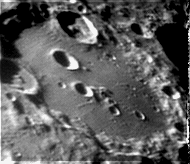Observing the Moon: Clavius
Jack Kramer
Almost three decades ago, the crater Clavius burst into the public consciousness as the site of a lunar colony -- and monolith -- in the movie 2001: A space Odyssey. For astronomers, it stands out in a jumble of other craters in an area of the Moon known as the "Southern Highlands". With dimensions of 132 by 152 miles, it's the second largest crater on the near side of the Moon. This size means that despite the fact that its walls rise to 16,000 ft., an astronaut standing in the center of the crater floor would see only a flat plain extending in all directions. The walls would be beyond the horizon due to the curvature of the Moon.

The floor of the crater is slightly higher in the center than at the edges. Thus if you catch the Moon with just the right angle of sunlight, you'll see the floor brightly illuminated with a ring of shadow at the base of the east and west walls. This effect is accentuated by the high latitude of Clavius near the southern limb. It's especially noticeable with Clavius on the terminator when the Moon is between 8 and 9 days old.
Superimposed on Clavius are a number of smaller craters. The largest are Clavius B and Rutherford on the northeast and southeast walls, respectively; each is about 30 miles in diameter. As the angle of illumination becomes higher, these craters don't stand out as well. An arc of progressively smaller craters lies on the floor of Clavius. The largest is Clavius D at 19 miles; the others have diameters of 14, 10, and 9 miles. Then there's a small craterlet at the very end of the chain up against the crater wall. (I nicknamed this one "Tiny".) This chain of craters may be visible even in binoculars. They're easy in my 4" refractor at about 150x, including the tiny one at the end of the chain. However, due to the shadow effect mentioned above, this little crater may be just barely illuminated. If you happen to observe when Clavius is at the terminator, over the space of just an hour you'll see some major changes in light and shadow. A shaft of darkness covers the little crater for awhile; it appears to be the shadow of an outcropping part way up the wall above "Tiny". You'll note many additional craters superimposed on the wide and rugged walls of Clavius...and let us know if you find any tall, black monoliths!
Published in the December 1996 issue of the NightTimes




